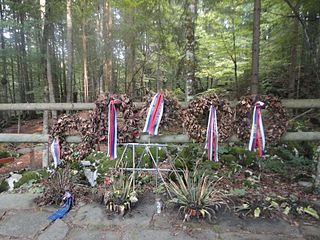| Ravenska Vas Sveti Urh (until 1955) | |
|---|---|
 | |
| Coordinates: 46°8′2.94″N15°1′8.49″E / 46.1341500°N 15.0190250°E Coordinates: 46°8′2.94″N15°1′8.49″E / 46.1341500°N 15.0190250°E | |
| Country | |
| Traditional region | Upper Carniola |
| Statistical region | Central Sava |
| Municipality | Zagorje ob Savi |
| Area | |
| • Total | 4.41 km2 (1.70 sq mi) |
| Elevation | 423.9 m (1,390.7 ft) |
| Population (2002) | |
| • Total | 214 |
| [1] | |
Ravenska Vas (pronounced [ɾaˈʋeːnska ˈʋaːs] or [ˈɾaːʋɛnska ˈʋaːs] ; Slovene : Ravenska vas, formerly Sveti Urh, [2] German : Sankt Ulrich [2] ) is a settlement immediately east and southeast of Zagorje ob Savi in central Slovenia. The area is part of the traditional region of Upper Carniola. It is now included with the rest of the municipality in the Central Sava Statistical Region. [3]

Slovene or Slovenian belongs to the group of South Slavic languages. It is spoken by approximately 2.5 million speakers worldwide, the majority of whom live in Slovenia. It is the first language of about 2.1 million Slovenian people and is one of the 24 official and working languages of the European Union.

German is a West Germanic language that is mainly spoken in Central Europe. It is the most widely spoken and official or co-official language in Germany, Austria, Switzerland, South Tyrol (Italy), the German-speaking Community of Belgium, and Liechtenstein. It is also one of the three official languages of Luxembourg and a co-official language in the Opole Voivodeship in Poland. The languages which are most similar to German are the other members of the West Germanic language branch: Afrikaans, Dutch, English, the Frisian languages, Low German/Low Saxon, Luxembourgish, and Yiddish. There are also strong similarities in vocabulary with Danish, Norwegian and Swedish, although those belong to the North Germanic group. German is the second most widely spoken Germanic language, after English.

Zagorje ob Savi is a town in the Central Sava Valley in central Slovenia. It is the seat of the Municipality of Zagorje ob Savi. It is located in the valley of Medija Creek, a minor left tributary of the Sava River, 52 km (32 mi) east of Ljubljana 36 km (22 mi) southwest of Celje, and 6 km (4 mi) west of Trbovlje. Traditionally the area was part of the Upper Carniola region. The entire municipality is now included in the Central Sava Statistical Region. The town is home to about 7,000 people. It includes the hamlets of Toplice and Podvine.













